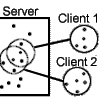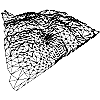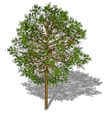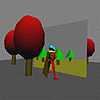 |
The Remote Rendering Pipeline
Managing Geometry and Bandwidth in Distributed Virtual Environments
Project duration:
1996-1999
Funding:
Austrian Science Foundation
 under contract no. P-11392-MAT
under contract no. P-11392-MAT
Contact:
Dieter Schmalstieg,
Michael Gervautz
|
Description
|
Improvement of network and rendering performance in
distributed virtual environments
|
Application
|
Users can meet in a simulated world for social exchange, collaboration
(computer supported cooperative work) and recreation.
|
Problems
|
The geometric description of this world (geometry database) must be available
on every participating computer to allow rapid image generation. Simple
solutions (such as found in computer games) often involve off-line
distribution of the database (e. g. on CD-ROM) or stall the image generation
until download is complete. The central problem is that the network
is simply too slow.
|
Approach
|
The remote rendering pipeline is a concept to improve the availability of
large geometry databases. It combines new methods in geometric modeling,
network protocols and 3-D image generation to build a virtual environment that
allows a large number of users to share a virtual world without waiting for
slow network transmission.
|
Publication
|
 The Remote Rendering Pipeline
The Remote Rendering Pipeline
D. Schmalstieg. Dissertation, Vienna University of Technology, 1997.
 A Network Architecture for Remote Rendering
A Network Architecture for Remote Rendering
G. Hesina, D. Schmalstieg.
Proceedings of 2nd International Workshop on Distributed Interactive
Simulation and Real Time Applications (DIS-RT'98), pp. 88-91,
Montreal, Canada, July 19-20, 1998.
|
| Technical background |
|
 |
Demand-driven geometry
network protocol:
For a virtual environment running in a client-server network configuration, an
application protocol was developed that delivers pieces of the geometry
database to the client "just in time" for rendering.
|
 |
Level of detail modeling for VRML
:
Geometric objects are represented at multiple
levels of detail. The coarser representations are less pretty, but can be
rendered faster and require less storage space. A level of detail generator
for the popular VRML geometry standard was developed.
|
 |
Smooth Levels of Detail
:
Smooth Levels of Details (SLOD) were developed to allow a
near-continuous geometry representation
unlike traditional geometric models, that are only usable as a whole,
every byte of the new data structure that is received over the network
becomes immediately usable.
the algorithm also yields a 3:1 data compression that further speeds up
the network transmission
|
 |
Animated Smooth Levels of Detail
:
In a follow-up project, the Animated Smooth Levels of Detail (ASLOD) approach was extended to support
hierarchical scene graphs as well as organically deformable models.
The resulting Animated SLOD or ASLOD system can render polygon
geometry in a view dependent fashion.
|
 |
Natural phenomena from procedural
models
Very realistic and pretty natural phenomena such as trees, plants, and
mountains can be defined by computer programs rather than modeled by hand.
Such programs are often 100 x smaller than the raw geometric model and can
therefore be transmitted over the network extremely fast.
|
 |
Spatially Extended Anchor Mechanism
:
The Spatially Extended Anchor Mechanism (SEAM) is
a new paradigm of connection complex assemblies of distinct virtual
worlds. SEAMS resemble doors between worlds, and are a powerful tools for
organizing large networked virtual universes. They can also be used
as "magic lenses" for enhancing user interfaces.
|

 under contract no. P-11392-MAT
under contract no. P-11392-MAT
 The Remote Rendering Pipeline
The Remote Rendering Pipeline
 A Network Architecture for Remote Rendering
A Network Architecture for Remote Rendering





